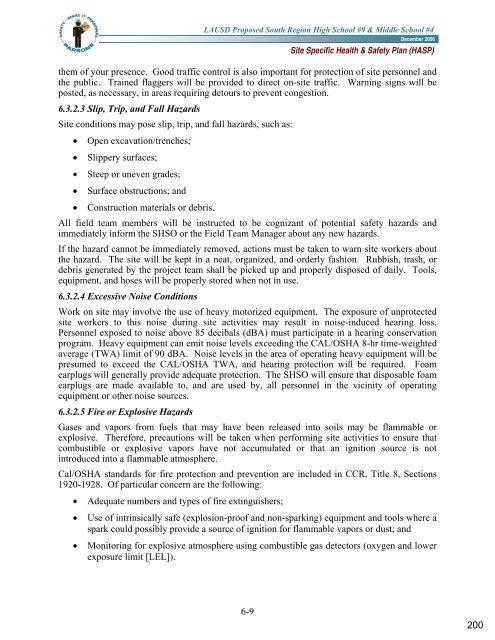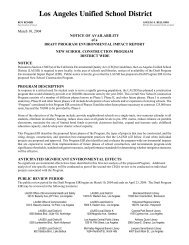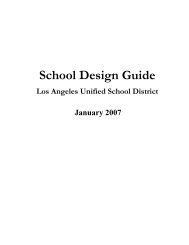Site-Specific Health and Safety Plan (HASP) - Laschools.org
Site-Specific Health and Safety Plan (HASP) - Laschools.org
Site-Specific Health and Safety Plan (HASP) - Laschools.org
Create successful ePaper yourself
Turn your PDF publications into a flip-book with our unique Google optimized e-Paper software.
LAUSD Proposed South Region High School #9 & Middle School #4<br />
6-9<br />
December 2006<br />
<strong>Site</strong> <strong>Specific</strong> <strong>Health</strong> & <strong>Safety</strong> <strong>Plan</strong> (<strong>HASP</strong>)<br />
them of your presence. Good traffic control is also important for protection of site personnel <strong>and</strong><br />
the public. Trained flaggers will be provided to direct on-site traffic. Warning signs will be<br />
posted, as necessary, in areas requiring detours to prevent congestion.<br />
6.3.2.3 Slip, Trip, <strong>and</strong> Fall Hazards<br />
<strong>Site</strong> conditions may pose slip, trip, <strong>and</strong> fall hazards, such as:<br />
• Open excavation/trenches;<br />
• Slippery surfaces;<br />
• Steep or uneven grades;<br />
• Surface obstructions; <strong>and</strong><br />
• Construction materials or debris.<br />
All field team members will be instructed to be cognizant of potential safety hazards <strong>and</strong><br />
immediately inform the SHSO or the Field Team Manager about any new hazards.<br />
If the hazard cannot be immediately removed, actions must be taken to warn site workers about<br />
the hazard. The site will be kept in a neat, <strong>org</strong>anized, <strong>and</strong> orderly fashion. Rubbish, trash, or<br />
debris generated by the project team shall be picked up <strong>and</strong> properly disposed of daily. Tools,<br />
equipment, <strong>and</strong> hoses will be properly stored when not in use.<br />
6.3.2.4 Excessive Noise Conditions<br />
Work on site may involve the use of heavy motorized equipment. The exposure of unprotected<br />
site workers to this noise during site activities may result in noise-induced hearing loss.<br />
Personnel exposed to noise above 85 decibals (dBA) must participate in a hearing conservation<br />
program. Heavy equipment can emit noise levels exceeding the CAL/OSHA 8-hr time-weighted<br />
average (TWA) limit of 90 dBA. Noise levels in the area of operating heavy equipment will be<br />
presumed to exceed the CAL/OSHA TWA, <strong>and</strong> hearing protection will be required. Foam<br />
earplugs will generally provide adequate protection. The SHSO will ensure that disposable foam<br />
earplugs are made available to, <strong>and</strong> are used by, all personnel in the vicinity of operating<br />
equipment or other noise sources.<br />
6.3.2.5 Fire or Explosive Hazards<br />
Gases <strong>and</strong> vapors from fuels that may have been released into soils may be flammable or<br />
explosive. Therefore, precautions will be taken when performing site activities to ensure that<br />
combustible or explosive vapors have not accumulated or that an ignition source is not<br />
introduced into a flammable atmosphere.<br />
Cal/OSHA st<strong>and</strong>ards for fire protection <strong>and</strong> prevention are included in CCR, Title 8, Sections<br />
1920-1928. Of particular concern are the following:<br />
• Adequate numbers <strong>and</strong> types of fire extinguishers;<br />
• Use of intrinsically safe (explosion-proof <strong>and</strong> non-sparking) equipment <strong>and</strong> tools where a<br />
spark could possibly provide a source of ignition for flammable vapors or dust; <strong>and</strong><br />
• Monitoring for explosive atmosphere using combustible gas detectors (oxygen <strong>and</strong> lower<br />
exposure limit [LEL]).<br />
200







